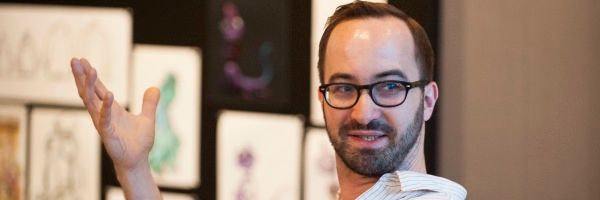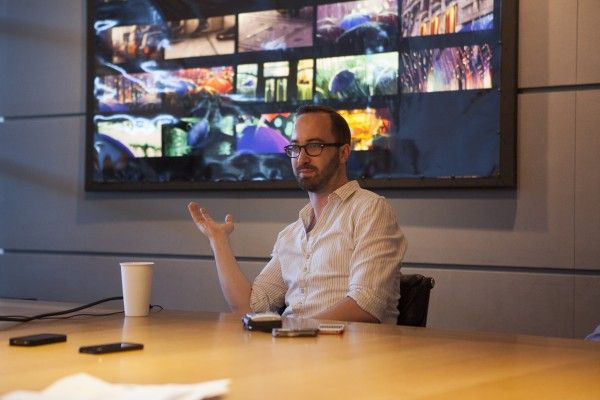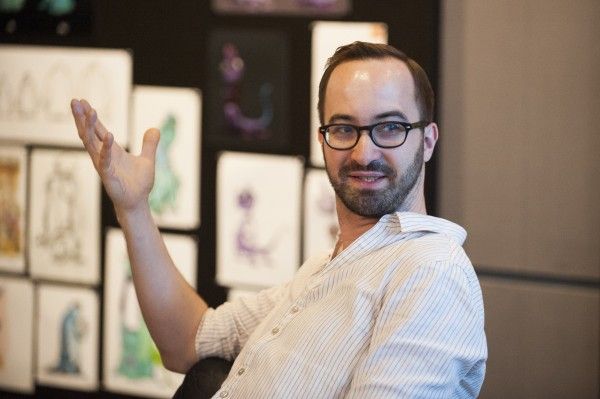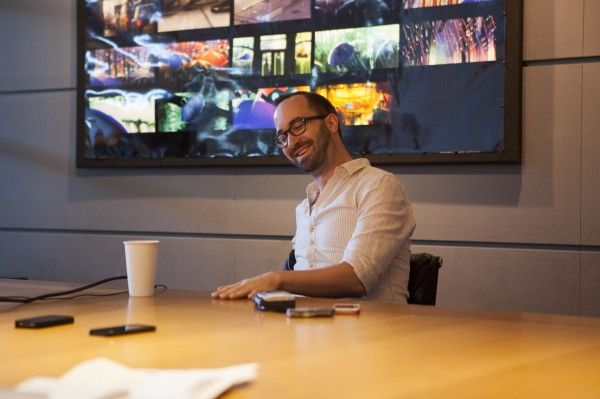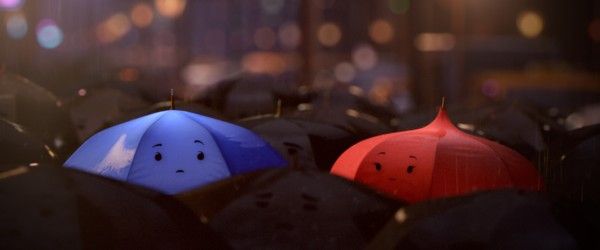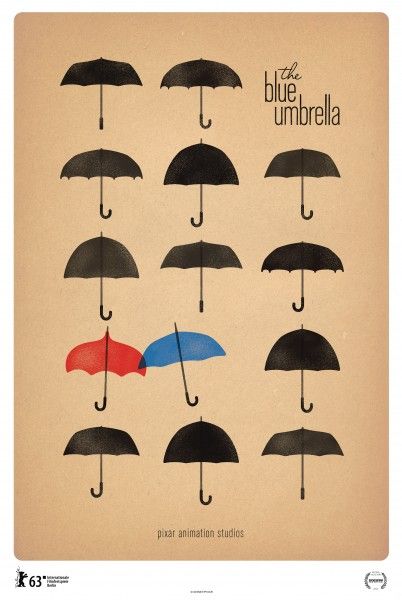During our recent set visit to Pixar Animation Studios, we were treated to a special screening of The Blue Umbrella, the short film that will be playing in front of Monsters University when it opens on June 21st. I was able to sit down with the film’s director Saschka Unseld for a one-on-one interview. We talked about his learning experience in making the short film, bringing inanimate faces in the cityscape to life, giving each character personality, the use of colors in the film and his favorite creation. Hit the jump for the full interview.
Question: From the experience of directing this short, what were some things you learned from a technical aspect that you think you can apply to your work going forward? And what were some creative things you learned from this experience?
SASCHKA UNSELD: For me, it was a very interesting experience directing for a big company like this because, before, it was so different when you’re just a small group of people. And we’re a small group of people in our feature, but I always compared it with, we used the production pipeline of a feature studio for a short is kind of like, what you wanna do is just grocery shop around the corner but you have to take this aircraft carrier that takes 100 people to just start up. And that’s kind of how it felt sometimes. Because features take so much work and even the shorts take a lot of work, things are split up into a million different pieces at one point. In the beginning, it’s just the storyboard, but then, it’s modeling it, and the effects here and stuff there, people set at different places and different departments. There are different managers – all that stuff.
Things that are not contained within one department are really hard to do. For example – taking a simple thing as seeing a character in a reflection – is something where Layout needs to set up the shot that way, but we don’t really know if the angle of the reflection works. Then, if it’s a puddle of water, Effects needs to somehow put that in there and the set needs to be modeled in a way that the water can stay there while Lighting will light the shot so that it’s probably done. Things like this are super hard to do because it needs someone that constantly tracks it and pushes it through and no one forgets about it. So much falls in between the cracks. And that’s something I think, creatively, that there’s tons of stuff we can do storytelling-wise that we don’t do with films because it’s so hard to push it through all these different departments over such a long production time.
On a more technical level, I think there’s better ways of working on something. A lot of it has to do with working on layers. We do the whole thing in a general, just getting stuff done, and we improve the whole thing and improve the whole thing. But again, because of the departmentalization, it’s really hard to do that. And the way production works is they track basically every single object in the film, and the way they stay on top of it is to mark things down. Well, if that something is “kind of done,” that’s not progress. So, to a certain way, the way we track the production dictates the way we work, which, it should be the other way around.
So, getting that overview experience of how different departments work together was really interesting, because I felt like, there are different creative ways to do things, but we need to change the way we produce things. The nice thing is that, to a certain extent, Pixar reinvents the wheel with every production because, everyone takes from older production what they like, while trying out newer things. That’s what we tried with the short, and everyone is interested in finding out different ways of making film on a feature as well.
That’s a great way to explore new opportunities. When I first sat down to watch the feature that was my first exposure to it. As soon as I knew what was going on, it brought an immediate smile to my face. We talked earlier about how humans see faces in everyday objects. First of all, what was your favorite face character that you guys designed?
SASCHKA UNSELD: To a certain extent, it’s actually the very first one.
I’m trying to remember which one that is.
SASCHKA UNSELD: It’s the one on the asphalt floor, because that was part of the test I had shot on my phone as well, and so, for some reason, I really really liked that character. But I loved the Flip Flop, you know, the traffic light, because they’re really twins, we just never show the second one. It’s just theoretically the twin on the other side of Flip who is facing the other way. And those I really like.
Those were cool, especially the first one, which was an introduction that wasn’t immediate or overt until the raindrop soaked in. I personally liked Omar because-
SASCHKA UNSELD: Yeah. Omar’s funny because he works instantly. Just one shot and then you’re out of it.
Are you seeing faces everywhere you walk now?
SASCHKA UNSELD: I still do. During the production, I started a blog, and since we weren’t officially announced it yet, I didn’t have anything to post. But I wanted to do something, so I started to take pictures of faces, and I gave them names and wrote small, three-sentence stories about them. I did this everywhere, even when I went down to LA to meet with John Bryan and I was sitting in a cab, and I saw a face so I took a picture of it, posted, and wrote a story about. It was kind of the idea of the world exists the whole time. That was nice. That was a lot of fun.
I really like the storyline as you go through. Not just the love story, but the supporting cast of all these different faces. They’re not only just watching the story happen and pulling for the blue umbrella, but they also help him, out of harm’s way and back into the love situation. Can you talk about giving some personality to each of these individuals? Was it an instinct or an emotion you wanted for each one or did you have specific breakdowns?
SASCHKA UNSELD: They were all very specific. When I talked with the animator, it was, “this should be kind of an older character,” and “this should be a really young and kind of flippy character.” I wanted a wide range of it, because I feel like if you live in a big city, especially if you know your neighborhood and the weird characters that live there, it’s such a breadth of different personalities, like the weird lady that lives on the corner and the strange guy that owns the grocery store. I wanted to get that feeling of living in a big city where there’s all these different personalities there and they’re all completely different and, I wanted to get that idea through the characters. That’s why we tried to find characters that are all vastly, in scale but also in character, and the speed they move and the way they act, and all these different things.
I think that definitely came across. I was also struck by not only the blue umbrella himself and how bold and youthful and sort of innocent he was, because he’s surrounded by all these muted colors that are just these sad umbrellas doing their job and not taking in their surroundings. Obviously that was intentional, but what was your thought process in separating him from the others like that, in his color and all?
SASCHKA UNSELD: It was actually very interesting, because I didn’t have it that way in the pitch. In my pitch what I said was, it starts to rain and a collective sigh goes through the crowd, and hundreds of umbrellas pop up. Then we pan through these groups of grumpy people to the world of the umbrellas, and they’re all live and happy and smiling and laughing. So, the contrast was always there of loving the rain and hating the rain, but I used to have that with the people and the umbrellas because of course all of the umbrellas are happy that they are out. But then, it became relatively quickly clear that I don’t want to put attention on the owners, and I still wanted that one umbrella to stick out. That contrast between the umbrellas and the owners became blue versus all the other umbrellas, so all the other umbrellas are a bit more representative of their owners, and blue and his owner stick out.
It was an interesting process of getting there because initially, we had this vast world of umbrellas, like funny dotted ones, or kind of a group of three kid umbrellas that moved very differently - the umbrella’s movement telling so much about the owner – like an old person or a kind of striding person. Sadly, that all fell away, but it made sense to do that compromise, because otherwise you wouldn’t see that contrast as much.
Sure. I know you said you only take things one step at a time. Is there anything you have lined up creatively, like as a next project? Either something you’d like to do or something that’s already in place?
SASCHKA UNSELD: I have quite a few ideas I’m writing on, which it’s hard to make me happy with the ideas. I mean, there’s a core to them that I love that I just need to work on to make them a solid story. And then, I always do stuff on the side, like this short actually convinced me that it’s good to do things for no reason at all on the side, just to be experimental. I do weird things on the side just for fun of it, or collaborate with friends on things like this. It’s kind of a mixed focus of doing stuff on the side but also figuring out if I can get the stories I’m writing onto something that I’m really happy with.

